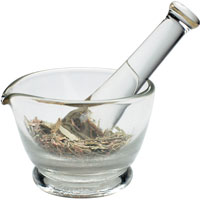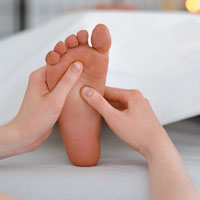Traditional medicine has made some giant strides in treating hemophilia. Yet for a variety of reasons, some patients choose to look outside of mainstream medicine for additional medical care through complementary and alternative medicine.
Complementary and alternative medicine (CAM) therapies have not yet been tested by the traditional methods of Western medicine. They lack the placebo-controlled, randomized studies that most conventional treatments and medications go through before widespread acceptance.
“By definition, CAM are treatments that have not been proven to work,” says Bradley Lewis, MD, chief of hematology at San Francisco General Hospital. “When something is proven to work, it becomes part of traditional [Western] medicine.”
CAM is made up of two different branches: complementary medicine, which is used with conventional medicine, and alternative medicine, which is used in place of conventional medicine. This article will focus on complementary practices, which are used in addition to, but not instead of, traditional medicine.
“When talking about CAM, evaluation of a therapy begins with the foundation of Western medicine: first do no harm,” Lewis says. “It needs to be well understood that CAM therapies should never prevent someone from using known-to-be-effective traditional treatments.”
Despite a lack of studies of their usefulness and safety, interest in CAM is growing. Approximately 38% of adults in the US ages 18 and older, and nearly 12% of children 17 and younger, use some form of CAM, according to the 2007 National Health Interview Survey, a nationwide survey developed by the National Center for Complementary and Alternative Medicine (NCCAM). The most commonly used CAM therapies were nonvitamin, nonmineral, natural products, such as fish oil, echinacea, ginseng or flaxseed oil or pills. Also common were deep-breathing exercises, meditation, chiropractic or osteopathic manipulation, massage and yoga. Deep breathing, meditation, massage and yoga all showed significant increases from 2002 to 2007.
CAM exists because there are perceived gaps in traditional medicine’s ability to address some issues in the treatment of disease. The current therapy may not be very effective, may cause unpleasant side effects or may be expensive. Some cultures, such as the Chinese, have a long tradition of using herbs to treat diseases. Others may have a culture-based distrust of Western medicine. For these people, looking for medical alternatives outside of the mainstream becomes attractive.
Doing Your CAM Homework
In some ways, the decision to pursue complementary treatment is the easy part of the process. Difficulties arise when one tries to sort through the many different methods, types of practitioners and treatments that are available. Finally, and most important, safety and effectiveness must be assessed. Careful research is extremely important in deciding your course of action.
Word-of-mouth is probably the primary way most people first learn about various CAM options. People who have hemophilia or care for people with it often share ideas and experiences in support groups, in waiting rooms and other places, telling each other about things they have tried and what has worked for them.
“In CAM, treatments can be passed on from person to person for decades,” Lewis notes. “One thing to keep in mind is that if 100 people use the treatment and only one gets better, that is the person who  is going to be telling everyone else what a great idea this is.”
is going to be telling everyone else what a great idea this is.”
New potential remedies pop up frequently, but the hype often outpaces the science. For example, probiotics—living microorganisms similar to the healthy bacteria in the gut—found in yogurt are touted as helping relieve gastrointestinal discomfort. Researchers are examining probiotics’ ability to treat diarrhea, irritable bowel syndrome, inflammatory bowel disease, tooth decay and periodontal disease, vaginal infections, skin infections, and stomach and respiratory infections in children, according to NCCAM. But the research is still in its early stages, so consumers should be careful when using probiotics.
It is vitally important to do extensive research and not use word-of-mouth as your only source of information on a possible treatment. One place to start is with the National Institutes of Health, which maintains information on complementary medicine through NCCAM. Among NCCAM’s suggestions for assessing the reliability of information on CAM are:
- Tell your traditional healthcare team about the therapy you are considering. Ask them about safety, effectiveness or interactions with medications (prescription or nonprescription).
- Use the Internet to search medical libraries and databases for information (“CAM on the Web,” see sidebar).
- Visit your local library, bookstore or a medical library to find books or publications that contain scientific articles discussing CAM in general or the treatment in which you are interested. A reference librarian can help you locate information on the therapies you are researching.
In addition, many handbooks on the use of herbs and supplements and CAM treatments can be found at your local library or bookstore. Another consideration is the cost for CAM treatments. Ask your insurance carrier if it covers CAM therapies.
Opening Communication Lines With Your Healthcare Team
“I had asked the team at my hemophilia treatment center (HTC) on several occasions about various treatments and products, and they had no information to give me,” says Amy Williamson of Charleston, South Carolina, the mother of a three-year-old child with moderate hemophilia A. “I then contacted the National Hemophilia Foundation, which sent me information on things that might cause complications and a list of things that were safe. This was an extremely valuable resource.”*
Williamson’s experience illustrates that the first person you might go to for information about complementary treatments—your doctor—might not feel it is appropriate to comment on an area outside of his or her expertise. The lack of hard data on both the usefulness and safety of CAM treatments may contribute to some treaters’ hesitation to discuss other options. In researching this article, most of the traditional providers contacted declined to be interviewed. They often said they did not have a clear enough understanding of the subject to comment.
“During our last clinic appointment at the HTC, I approached the nurse and hematologist about alternative therapies and they were nonresponsive,” Williamson says. “They focus on prevention and traditional medicines, which are all necessary, but they don’t seem to want to discuss the possibility that alternative treatments may be helpful as well.”
Lewis warns that ignorance or dismissing a patient’s curiosity about CAM therapies may have consequences in treatment outcomes. For example, a person may begin an herbal therapy that has aspirinlike effects on platelet function. If he or she does not tell the traditional physician, then there is a risk of additional, unexplained bleeding.
“If physicians dismiss these ideas out of hand, then the patients are being taught they should not talk with us about such things,” Lewis says. “However, they still find out about CAM and use the therapies anyway. The point is that both parties need to keep open the lines of communication.”
Among the risks in not telling your traditional healthcare provider what CAM treatments you are taking are:
- Individual risks, such as other conditions (e.g., liver disease, HIV/AIDS), or food, alcohol or other drug interactions.
- Poor data collection systems or monitoring for complementary medicine that may lead to underestimation of bad effects and overestimation of good ones.
- Few quality risk-versus-benefit analyses for many treatments.
Pain, Pain, Go Away
A variety of CAM modalities are used to address joint pain in general, and arthritis pain in particular. Certain herbs and supplements derived from naturally occurring substances in plants are taken by mouth like conventional medications. However, the US Food and Drug Administration (FDA) does not regulate herbs and supplements the same way it does food and drug products—prescription and over-the-counter medications.
“Under the Dietary Supplement Health and Education Act of 1994 (DSHEA), the dietary supplement manufacturer is responsible for ensuring that a dietary supplement is safe before it is marketed,” according to the agency. “FDA is responsible for taking action against any unsafe dietary supplement product after it reaches the market. Generally, manufacturers do not need to register their products with the FDA nor get FDA approval before producing or selling dietary supplements. Manufacturers must make sure that product label information is truthful and not misleading.”
As with the pursuit of any treatment, decisions about using herbs and supplements should only be made in close consultation with your healthcare team. Many products may interfere with clotting and have actions that are similar to blood-thinning agents such as aspirin or coumadin. For example, glucosamine and chrondoitin sulfate, used widely for treating the pain of arthritis, and omega fatty acid supplements or herbals such as willow bark tea, may have aspirinlike effects.
Alternative treatments are used not just for pain management but also to treat certain conditions. Research on the use of the herb milk thistle to treat liver cirrhosis and chronic hepatitis has shown some promising findings. However, studies have been small, according to NCCAM. People with bleeding disorders who have a liver condition should contact their provider before using milk thistle or other herbs.
Some therapies may not directly relieve pain, but may offer indirect benefits. Meditation is another possible approach to cope with pain caused by bleeds in those with hemophilia. There appears to be little or no downside for its use in these patients, according to Lewis. Studies of other types of chronic pain appear to show positive pain-lowering results with the use of disciplines such as meditation and tai chi, considered a “soft” martial art.1 As an exercise program, tai chi consists of slow, controlled movement and gentle stretching of the joints that aid coordination and stability.
[Steps for Living: The Pain Facts]
“Programs using alternative therapies such as tai chi and meditation in combination with traditional medications appear to be beneficial for patients with arthritis,” the researchers conclude. “These individuals appear to live better lives and may have better long-term outcomes.”1
“We know that people can change the way they feel, their blood pressure, energy level and even their sense of what their pain is like with meditation,” Lewis says. “Similarly, we don’t use hypnotherapy anywhere near as often as we should.”
Yoga is another form of exercise that incorporates stretching, strengthening and balance. It can be useful for people with bleeding disorders, but they should make sure that the classes they take are appropriate for people with arthritis or other joint conditions and not too advanced for their fitness level and ability.
“The person has to take into account his or her personal target-joint limitations,” says Sherry Herman-Hilker, a physical therapist at the University of Michigan Adult Hemophilia and Coagulation Disorders Program in Ann Arbor. “The forms (of exercise) that a person with ankle problems should do are probably different from those undertaken by a person with elbow bleeding concerns.”
 This is an individualized concern that should be carefully explored in consultations between the patient, traditional medicine treatment team and the complementary practitioner. Massage therapy also can be useful in lessening pain, improving stress relief, and inducing relaxation and decreasing muscle spasms. Massage has a long track record in helping athletes with joint and muscle problems. Lewis cautions that deep tissue massage should be avoided by those with a bleeding disorder because of the possibility of causing a bleed in the muscles. However, more superficial massage should not be a problem, he says.
This is an individualized concern that should be carefully explored in consultations between the patient, traditional medicine treatment team and the complementary practitioner. Massage therapy also can be useful in lessening pain, improving stress relief, and inducing relaxation and decreasing muscle spasms. Massage has a long track record in helping athletes with joint and muscle problems. Lewis cautions that deep tissue massage should be avoided by those with a bleeding disorder because of the possibility of causing a bleed in the muscles. However, more superficial massage should not be a problem, he says.
In craniosacral therapy (CST), gentle pressure is applied to the head and spine, which is thought to correct imbalances and restore the proper flow of the fluid that surrounds the brain and spinal cord. Studies to date have shown little indication of its usefulness, but many who use it swear by it.
“When our son was diagnosed with hemophilia, one of the things we looked into was CST,” says April Bennett of Lyndhurst, Virginia. “It has helped with pain, fluid reabsorption, nerve protection and general trauma recovery.”
Some oils made from herbs and other plant materials are thought to enhance pain relief when used topically in conjunction with massage or when inhaled as part of aromatherapy. For example, lavender oil has been shown to cut pain medication use in people with arthritis.2 Capsaicin cream, made from chili peppers, has been shown to alleviate pain in general.3 However, it should be stressed that there are no studies showing that either therapy works in those with pain secondary to hemophilia.
There appear to be no concerns about use of most oils in people with hemophilia, especially since most of them are only used on the skin, Lewis says. He notes that some people may occasionally develop rashes, but they resolve quickly when the treatment is stopped.
Acupuncture and acupressure are two other treatment options people have turned to for help in managing pain. Acupuncture is a traditional Chinese medical technique used to unblock natural energy forces in the body called qi (pronounced “chi”) by inserting needles at particular points on the body to balance the opposing forces of ying and yang. This balance is thought to be essential to health. In contrast, acupressure uses hands instead of needles to achieve the same effect.
Acupuncture is not contraindicated in hemophilia, according to the Canadian Hemophilia Society (CHS). However, CHS recommends that replacement therapy be used before the first treatment. Chronic pain and muscle spasm respond well to acupuncture, the society reports.
“Care should be taken when undergoing acupuncture treatments to make sure that the needles used are not too long,” Lewis says. “When they only press into the skin and fat, there are probably no major concerns. Overall, acupressure is probably safer.”
Identifying a Skilled CAM Provider
Finding a competent complementary medicine practitioner can be a major problem. In many cases there are no widely recognized licensing or other credentialing programs available. In contrast with traditional medicine, even when licensing or certification is available for CAM providers, there can be large variations in requirements between states. This may be related to the lack of hard data from studies.
In addition, accreditation is not standardized for those teaching various CAM approaches. Training in the same discipline can vary from a few hours on the Internet to a couple of years of schooling.
“It is really important to see a person who either has an interest in hemophilia or is willing to learn,” Herman-Hilker says. “Then they can work together with the traditional medicine treatment team to make informed decisions about what is an appropriate regimen to follow.”
Lewis echoes this. “One of the criteria [for choosing a CAM practitioner] should be a willingness to stay in touch with me, help me understand what they are doing, and let me help them understand what I am doing and how their therapy might hurt instead of help, if that is the case.”
Other suggestions from Lewis to those with bleeding disorders who are considering CAM include:
- Talk to others in a similar situation and get recommendations.
- Ask the CAM providers if they are willing to make changes in their suggested regimen to reflect the specific needs of the patient.
- Talk to the practitioners and assess their understanding of hemophilia in general and your needs in particular.
- Find out if they are willing to educate themselves about hemophilia.
- Ask if they are willing to contact your traditional medicine treatment team to coordinate care.
“Most people with hemophilia have a list of questions or concerns to assess how familiar emergency room staff and other nonspecialists are with hemophilia,” Lewis says. “Those kinds of questions are also good to use when interviewing alternative medicine practitioners.”
NCCAM has information on various CAM-related treatments on its Web site (See sidebar “CAM on the Web”), as well as suggestions on how to find an appropriate provider. It publishes the general fact sheet, “Selecting a Complementary and Alternative Medicine (CAM) Practitioner.”
Lewis summarizes why pursuing CAM can be a thorny path that requires careful navigation, “I have talked with traditionally oriented doctors and patients who think [CAM] is a scam,” he says. “Then there is the group that thinks CAM must be good because it is natural, and thus has to be safe and effective; and it isn’t. The reality is that CAM is better than some people think and nowhere near as good as others believe.”
*Note that NHF’s Information Resource Center, HANDI, does not have one comprehensive resource on CAM, but uses many different resources, including HemAware articles, the Internet and other organizations’ materials to fulfill a request. Each request is handled individually, taking into consideration the individual’s health conditions.

